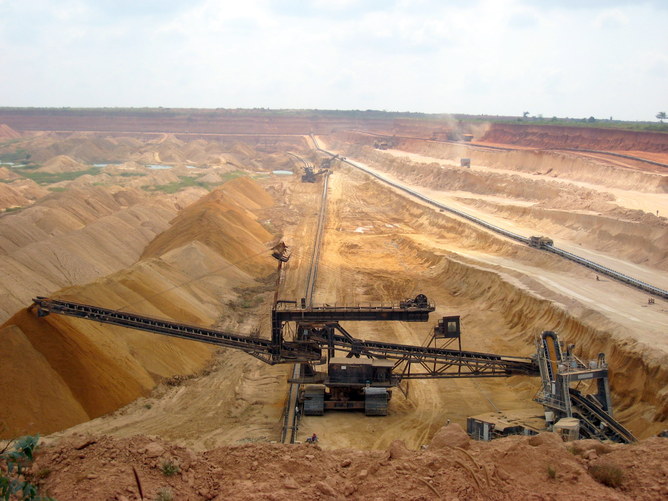
Peak Phosphorus Will be a Shortage We Can't Stomach (Op-Ed)

This article was originally published at The Conversation. The publication contributed the article to Live Science's Expert Voices: Op-Ed & Insights.
Here’s the good news. We probably don’t have to worry about peak oil just yet, as it isn’t going to run out anytime soon. The bad news is, as the IPCC has recently reported, we can’t afford the costs of what liberating all that carbon into the Earth’s atmosphere would do to the climate. So we will have to leave it in the ground and come up with alternatives fast.
The really bad news is that we may not even have to worry about peak oil or dangerous climate change – instead we can fret over peak phosphorous. Unlike moving from our current dependence on fossil fuels, there is no alternative to phosphorus and if it runs out our global food production system would grind to a halt.
Phosphorus is present in all cells in all forms of life because it makes up part of the backbone of DNA – you can’t make DNA without phosphorus. We get our phosphorus by eating plants that have drawn up phosphorus through their roots, or by eating animals that ate the plants (or from expensive tablets).
Many plants do just fine by consuming the natural levels of phosphorus in the soil, but modern intensive farming methods quickly suck up phosphorus, which needs to be continually replaced. If you keep growing high yield crops on land that is irrigated with water and doused with pesticides, then you are going to come up against phosphorus limitation. And if you don’t plug that hole with fertilisers yields will dramatically decline.
Did farmers have this problem in the past? Yes, but they solved it in different ways. They fertilised their fields with phosphorus and nitrogen from animal waste. Manure – from horses, cows, pigs, or chickens – has the nitrogen, phosphorus and other goodies that plants need.
Farmers would also change the types of crops grown on a particular field and leave it fallow for a season to recover. This system, crop rotation, has been used successfully since ancient times, and improved from two to three and four-field rotations during the middle ages. There are many good things about it, but in the quest for ever greater short term crop yields, the modern system of intensive monoculture (growing the same crop all the time) farming wins.
Sign up for the Live Science daily newsletter now
Get the world’s most fascinating discoveries delivered straight to your inbox.
But it wins because we make up for the inefficiencies of the crop-rotation system (different crops, different planting times, unproductive fallow years) by providing all the benefits it brings to the fields in the form of added fertilisers, pesticides and irrigation. All these elements of the agricultural Green Revolution requires large amounts of energy.
Imagine how much energy it takes to dig up phosphorus-bearing minerals, grind, and physically and chemically process it. Then transport it many miles, load it onto a spreader and tow it behind a tractor so that it finally gets onto a field. Digging up and burning stored solar energy (in the form of fossil fuels) allows us to extract phosphorus and put that onto fields in order to increase the amount of solar energy-using organisms (plants) we can grow and then eat.
The chemical crunch
If, or rather when, easily accessible phosphorus runs out we will either have to eat less, or decrease the amount lost from the system by increasing the quantity of phosphorus that is recycled. Recycling phosphorus from human and animal waste – back to manure again – or reducing the amount washed off from farmland in runoff will also take energy, probably a lot of energy due to the need for significant new infrastructure. We have the energy sources for this now, but will we when phosphorus scarcity really starts to bite? And when will that be?
Unsurprisingly it depends on who you ask. Upper estimates of mineral phosphorus resources (known concentrations in the ground) are about 300 years. Lower estimates for reserves (known concentrations in the ground that are technically and economically feasible to extract) are a few decades. The only thing certain is that limitations in phosphorus supply will increase the cost of phosphorus fertilisers and so the cost of food.

And here’s the double whammy: some estimates give a date of peak phosphorus around the middle of this century which is when the global population will reach its possible maximum of nine billion. This is also when Sir John Beddington, a previous UK Chief Scientific Officer argues that humanity will need to generate approximately 50% more power, gain access to 30% more fresh water and grow 50% more food. All while significantly reducing our total carbon emissions.
Just when we have the greatest number of mouths to feed in all of human history, our reserves of easy to obtain, low cost phosphorus may start to run out. The worse case scenario is that many people will starve. Avoiding that outcome will require more recycling and more efficient farming practices. Getting up and running on that will require energy. Where will that low carbon energy come from in the middle of the century?
Will we starve or will we cook the climate? OK, that’s a false dichotomy. We could instead look at the current situation in which one billion people go hungry while another billion overeat and consider alternative scenarios in which we all get access to healthy and nutritious food. That wouldn’t require breakthroughs in fusion power or wonder GM crops but something seemingly much more challenging: our ability to share the Earth’s resources more equitably.
James Dyke does not work for, consult to, own shares in or receive funding from any company or organisation that would benefit from this article, and has no relevant affiliations.
This article was originally published on The Conversation. Read the original article. Follow all of the Expert Voices issues and debates — and become part of the discussion — on Facebook, Twitter and Google +. The views expressed are those of the author and do not necessarily reflect the views of the publisher. This version of the article was originally published on Live Science.










